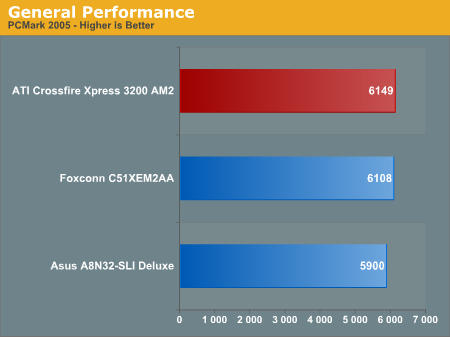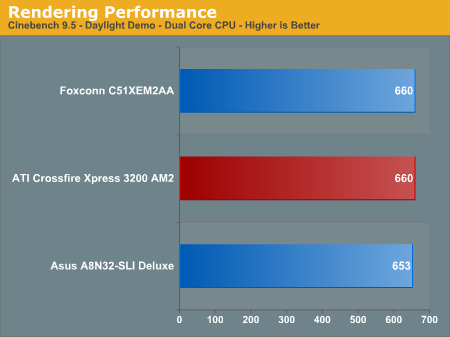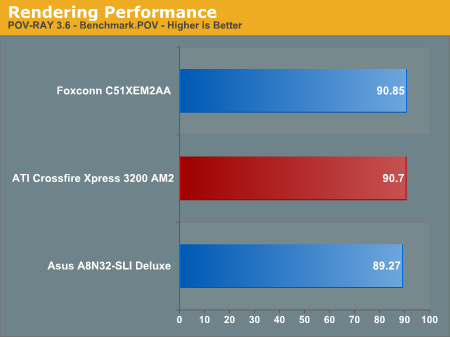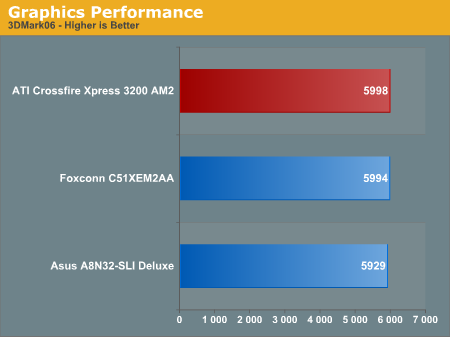CrossFire Xpress 3200: RD580 for AM2
by Wesley Fink on June 1, 2006 12:05 AM EST- Posted in
- Motherboards
General Performance
With the Memory Controller on the Athlon 64 Processor, Winstone benchmarks are no longer very revealing of motherboard performance. With the same CPU (and the same memory controller on that CPU) Winstones, both Business and Multimedia Content Creation, are tightly clustered. The only deviation from that is that boards that are tweaked for best gaming performance are often near the bottom of a tight range of benchmark performance numbers. The Winstone tests themselves are rapidly becoming dated, and are no longer supported by PC Magazine. While Winstones are still useful in providing real world performance data we are dropping Winstones from our standard motherboard test suite.

PCMark 2005 results with the ATI AM2 show the CrossFire Xpress 3200 AM2 with a 40 point lead. The nForce 590 and ATI AM2 should be considered equivalent in performance. Both show a 200+ point lead over the DDR-based Asus A8N32-SLI, consistent across both AM2 platforms.
Despite the close results in these tests, PCMark05 is proving to be a useful overall performance benchmark. It is generally more sensitive than the older Winstones and PCM04 to recent improvements in PC architecture. PCMark 05 results in general relate well to the other performance results we find in our board tests - providing a quick and reliable snapshot of board performance compared to other motherboards.



We have replaced Winstones with 2 benchmarks that use rendering to test system performance. Cinebench 9.5 and POV-RAY 3.6 benchmarks both heavily stress the CPU subsystem while performing graphics modeling and rendering. We utilize the standard benchmark demos in each program along with the default settings. Cinebench 9.5 features two different benchmarks with one test utilizing a single core and the second test showcasing the power of multiple cores in rendering the benchmark image.
Single-Core and POV-Ray results are extremely close across DDR and DDR2 platforms. However, Dual-Core Cinebench results show both NVIDIA and ATI AM2 chipsets with a larger lead over the DDR platform. Since all 3 systems were tested with a dual-core CPU at the same speed, this provides a bit of evidence that dual-core (and quad core potentially) can make better use of the extra DDR2 memory bandwidth.
3D Graphics
The 3DMark benchmarks, published by Futuremark, are probably the most widely quoted gaming performance benchmarks available. While the benchmarks are based on game sequences written by Futuremark to reveal subtle differences in gaming performance, they still have to be considered synthetic benchmarks. They are useful for broad graphics comparisons, but they are no substitute for benchmarks with real gaming engines that are currently being played.
SLI and CrossFire are also generally supported in 3DMark, but we ran 3DMark2005 and 2006 in standard mode only as we are not comparing SLI and CrossFire in this chipset review. Please take a closer look at CrossFire benchmarks later in this review for comparisons of CrossFire and SLI performance in several current games. 3DMark06 was recently introduced and you can find more in-depth information about this new 3DMark in the AnandTech article Futuremark's Latest Attempt: 3DMark06 Tested.


The 05 and 06 results both show the ATI AM2 in the lead, but the margin is small enough to be within the margin of error. Again, both AM2 boards outperform the DDR platform by several hundred points. The ATI and NVIDIA AM2 boards can be considered a dead heat in 3D Graphics performance.
Encoding
We have found encoding results are not affected by the graphics card used during the encoding benchmarks. This is demonstrated again and again by archive test results for AutoGK using an AMD 4000+ processor with a wide assortment of video cards. The performance range of those encoding tests is just 48.1 to 49.1 - a difference form high to low of just 1.0 frame. Clearly the biggest influence on this encoding benchmark is the CPU used for testing. Because encoding test results vary so little on the same standardized motherboard test platform, they have been dropped from this review and future reviews. Encoding tests are very useful in CPU testing, but they have been shown to be poor motherboard tests - particularly on the AMD platform with the memory controller on the CPU.
With the Memory Controller on the Athlon 64 Processor, Winstone benchmarks are no longer very revealing of motherboard performance. With the same CPU (and the same memory controller on that CPU) Winstones, both Business and Multimedia Content Creation, are tightly clustered. The only deviation from that is that boards that are tweaked for best gaming performance are often near the bottom of a tight range of benchmark performance numbers. The Winstone tests themselves are rapidly becoming dated, and are no longer supported by PC Magazine. While Winstones are still useful in providing real world performance data we are dropping Winstones from our standard motherboard test suite.

PCMark 2005 results with the ATI AM2 show the CrossFire Xpress 3200 AM2 with a 40 point lead. The nForce 590 and ATI AM2 should be considered equivalent in performance. Both show a 200+ point lead over the DDR-based Asus A8N32-SLI, consistent across both AM2 platforms.
Despite the close results in these tests, PCMark05 is proving to be a useful overall performance benchmark. It is generally more sensitive than the older Winstones and PCM04 to recent improvements in PC architecture. PCMark 05 results in general relate well to the other performance results we find in our board tests - providing a quick and reliable snapshot of board performance compared to other motherboards.



We have replaced Winstones with 2 benchmarks that use rendering to test system performance. Cinebench 9.5 and POV-RAY 3.6 benchmarks both heavily stress the CPU subsystem while performing graphics modeling and rendering. We utilize the standard benchmark demos in each program along with the default settings. Cinebench 9.5 features two different benchmarks with one test utilizing a single core and the second test showcasing the power of multiple cores in rendering the benchmark image.
Single-Core and POV-Ray results are extremely close across DDR and DDR2 platforms. However, Dual-Core Cinebench results show both NVIDIA and ATI AM2 chipsets with a larger lead over the DDR platform. Since all 3 systems were tested with a dual-core CPU at the same speed, this provides a bit of evidence that dual-core (and quad core potentially) can make better use of the extra DDR2 memory bandwidth.
3D Graphics
The 3DMark benchmarks, published by Futuremark, are probably the most widely quoted gaming performance benchmarks available. While the benchmarks are based on game sequences written by Futuremark to reveal subtle differences in gaming performance, they still have to be considered synthetic benchmarks. They are useful for broad graphics comparisons, but they are no substitute for benchmarks with real gaming engines that are currently being played.
SLI and CrossFire are also generally supported in 3DMark, but we ran 3DMark2005 and 2006 in standard mode only as we are not comparing SLI and CrossFire in this chipset review. Please take a closer look at CrossFire benchmarks later in this review for comparisons of CrossFire and SLI performance in several current games. 3DMark06 was recently introduced and you can find more in-depth information about this new 3DMark in the AnandTech article Futuremark's Latest Attempt: 3DMark06 Tested.


The 05 and 06 results both show the ATI AM2 in the lead, but the margin is small enough to be within the margin of error. Again, both AM2 boards outperform the DDR platform by several hundred points. The ATI and NVIDIA AM2 boards can be considered a dead heat in 3D Graphics performance.
Encoding
We have found encoding results are not affected by the graphics card used during the encoding benchmarks. This is demonstrated again and again by archive test results for AutoGK using an AMD 4000+ processor with a wide assortment of video cards. The performance range of those encoding tests is just 48.1 to 49.1 - a difference form high to low of just 1.0 frame. Clearly the biggest influence on this encoding benchmark is the CPU used for testing. Because encoding test results vary so little on the same standardized motherboard test platform, they have been dropped from this review and future reviews. Encoding tests are very useful in CPU testing, but they have been shown to be poor motherboard tests - particularly on the AMD platform with the memory controller on the CPU.










71 Comments
View All Comments
Saist - Friday, June 2, 2006 - link
to quote"short life for AM2 dominance before the launch of Conroe"
Um. Anandtech, if you actually do believe that Conroe's performance numbers are going to hold up in multithreaded applications that exceed 4megabytes of cache data, I think you need to redo you're calculations. After intel's showing of Conroe behind closed doors during E3, I think you should also be aware that the performance numbers are not adding up. Intel might finally be competitive, but even when Intel chips have been competitive in the past, AMD chips have won on price. AM2 may not be the only game in town come this fall, but to say it has a short life? Makes me wonder if you actually bothered even asking the game developers what they are getting out of the processors.
JarredWalton - Friday, June 2, 2006 - link
...multithreaded applications that exceed 4megabytes of cache data..."We believe in real world testing. I'm sure there will be applicaitons where AMD still comes out ahead, but synthetic scenarios don't really count. If http://techreport.com/etc/2006q2/woodcrest/index.x...">Intel wins in encoding tests, 3D rendering, gaming, office... and loses in a few specific benchmarks that require lots of memory and low latency RAM access, does it really mean AMD is competitive? I mean, there are still a few specific scenarios where P4 can beat A64, but you don't see us trumpeting those as being representative.
What it comes down to is what most people will get out of each platform, and so far it's looking like a pretty clean sweep for Core Duo 2. Woodcrest vs. Opteron in HPC applications might be a different story (I doubt it), but that's really only relevant if you're running server workloads. As far as pricing, http://images.dailytech.com/nimage/1556_large_conr...">last I saw the $300+ prices of dual core AMD chips are going to have a difficult time competing with $185-$225 Intel chips. Overclocks are also looking promising as well, so a $185 chip running 2.8 GHz will be a force to be reconned with.
R3MF - Friday, June 2, 2006 - link
can you tell me the what and the when of this amzing revelation?Slaimus - Thursday, June 1, 2006 - link
You can run CrossFire on 975X as well. It should be a competitive platform once the new CPUs come out.
Axbattler - Thursday, June 1, 2006 - link
Umm, the article made no mention of the Sil3132 performance on the A8R32-MVP, which I believe is bugged.Trisped - Thursday, June 1, 2006 - link
http://www.anandtech.com/mb/showdoc.aspx?i=2767&am...">http://www.anandtech.com/mb/showdoc.aspx?i=2767&am...First chart, #1 is the Silicon Image 3132 SATA2 (ATI) performance rating.
Axbattler - Thursday, June 1, 2006 - link
I saw that. But if you look at the second graph, the performance of the Sil 3132 in the MSI board is considerably worse than in the ATI reference board.That is still quite usable, but the one from the Asus A8R32-MVP is basically unusable (slower than what modern drives are capable).
Wesley Fink - Thursday, June 1, 2006 - link
We retested Sil3132 on the ATI and some other controllers for this review, and the other 3132 data should have been deleted. Now corrected. We are not aware of the 3132 issue with the A8R32-MVP. The Sil3132 is one of the best SATA2 controllers on the market, and it is a much better performer than the Sil3114.Axbattler - Thursday, June 1, 2006 - link
The result does shown in the review does suggest a solid performance from the Sil3132 controller. However, this is what I have been experiencing:- http://img267.imageshack.us/my.php?image=burst4dh....">http://img267.imageshack.us/my.php?image=burst4dh.... (Sil controller)
- http://img71.imageshack.us/my.php?image=burst27ja....">http://img71.imageshack.us/my.php?image=burst27ja.... (ULi controller)
Two motherboard bioses were tested (0311, 0404), as well as all the drivers from 1.0.9.0 (bundled with the motherboard installation CD, to the latest 1.0.16.0
The poor HDTach performance is reflected in real world application too, gaming loading, file copying are all slowed down to horrendous level.
I believe that Gary was able to replicate this issue (not sure if he eventually found a way around it), although I suppose that based on the result of the other board, it is an issue specific Asus board (perhaps the A8R32-MVP). Is there any chance you could run a test to confirm this?
Very few people in forums that I've visited use the Sil controller, perhaps due to the positioning of the SATA socket (which is actually optimal to where my Raptor is installed: on a 5.25" drive bay).
Trisped - Thursday, June 1, 2006 - link
ATI AM2.jpg is a bit blurry when blown up. You might want to set the camera on the highest quality setting so that doesn’t happen.0X looks like a typo
Why did the Audio Performance charts not have any NVIDIA solutions?